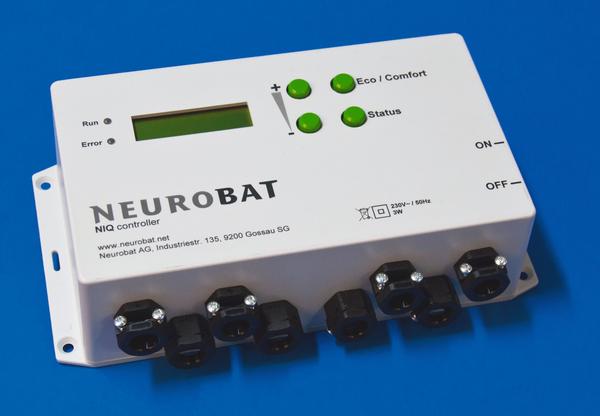A Heating System with a Brain

Each building has its way of dissipating the heat.
A start-up from EPFL and CSEM is putting on the market a thermal regulator that uses neural networks to learn about your house as the seasons change, allowing for savings of up to 65% on fuel.
Winter is still with us, and an efficient central heating system is essential. However, most of the existing installations only react to one single parameter – the outside temperature – in regulating their output. Researchers at EPFL have developed a system that manages multiple parameters and learns what is best for your house by imitating the most complex computer in the world – your brain. The technology has spun off into a new start-up called Neurobat (for Neuron and Batiment, the word for building in French).
Each building reacts differently to changes in temperature. If you put 20 people together in a room, it soon becomes stifling. Let a fierce winter sun come in through wide bay windows and fill your living room, and the temperature jumps several degrees while the radiators continue full blast.
“If we can manage to better take into account the properties of each building in terms of the habits of its users and its position with regard to the sun, it’s possible to make big energy savings,” notes David Lindelöf, technical director of Neurobat SA.

Glass-surrounded houses such as this villa overreact when exposed
to the sun. This one has been equipped with an intelligent heating system
which anticipates the rise in temperature.
From the lab to the markets
The company is a spin-off of work performed in the EPFL’s Solar Energy and Building Physics Laboratory (LESO-PB), where David Lindelöf and his associate Antoine Guillemin, scientific director, obtained their PhDs. Created within the framework of a partnership between EPFL and CSEM (Swiss Center for Electronics and Microtechnology) in Neuchâtel, Neurobat is preparing to launch on the market a control module that uses several distinct sources to finely adjust the output of central heating installations. “As well as the outside temperature, our device takes into account the level of sunlight – thanks to a solar sensor – and the way the dwelling itself reacts, using a thermometer placed in a dedicated room,” explains David Lindelöf. Moreover, a presence sensor enables an automatic lowering of the heating output when there is no-one at home.
“Neuronal” Intelligence
All the resulting data are integrated in a regulator that can be adapted to most existing installations. However, the engineers responsible for the development of Neurobat wanted to add a layer of “intelligence” based on an artificial neuronal network. “The system records these various parameters and links them together,” adds the technical director. “The more the system ‘learns,’ the more precise the adjustments can be. Eventually, it becomes capable of establishing predictive meteorological models that are specific to a given dwelling, and therefore more precise – and less expensive – than those provided by meteorological offices.”
 The Neurobat regulator has already been installed in several test buildings, among which are one at CSEM, and one in a private villa. Various tests have shown savings in fuel up to 65%, which suggests that savings of around 50% are envisageable in an average building. The relevance of this approach earned the company this year’s Swiss Environment Award, which was presented recently at the Swissbau trade fair in Basel. This gives a boost to the company, as it prepares to go on the market in the coming weeks.
The Neurobat regulator has already been installed in several test buildings, among which are one at CSEM, and one in a private villa. Various tests have shown savings in fuel up to 65%, which suggests that savings of around 50% are envisageable in an average building. The relevance of this approach earned the company this year’s Swiss Environment Award, which was presented recently at the Swissbau trade fair in Basel. This gives a boost to the company, as it prepares to go on the market in the coming weeks.